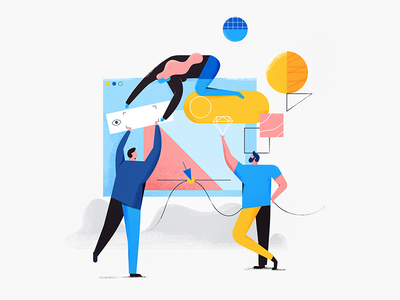

With both teams using the same UI elements, there’s no drift, and engineers can copy components from the repository to start development. See how Component Manager works.Īny changes designers make to components render JSX, so engineers only need to copy and paste to apply the changes.
Avocode design soft code#
You simply drag and drop code components to build user interfaces and high-fidelity prototypes.Įngineers can help designers to edit components using React props (or Args for UXPin’s Storybook integration) which appear in the properties panel of UXPin’s design editor, but with a brand new Merge Component Manager, designers can manage the props in UXPin. Designers use these components as they would in any image-based design tool, but with code-like fidelity and functionality, including interactivity and animations. “The results seems to obey the desired semantics, which I think is pretty impressive.” Jaemin Cho, a colleague of Kembhavi’s, is also impressed: “Existing text-to-image generators have not shown this level of control drawing multiple objects or the spatial reasoning abilities of DALL♾,” he says.You can sync your company’s design system or a front-end component library like MUI. “The ability of the model to generate synthetic images out of rather whimsical text seems very interesting to me,” says Ani Kembhavi at the Allen Institute for Artificial Intelligence (AI2), who has also developed a system that generates images from text. Images drawn by DALL♾ for the caption “snail made of harp” “The real test is seeing how far the AI can be pushed outside its comfort zone,” says Riedl. Riedl suggests that asking a computer to draw a picture of a man holding a penguin is a better test of smarts than asking a chatbot to dupe a human in conversation, because it is more open-ended and less easy to cheat. It assumes that one mark of intelligence is the ability to blend concepts in creative ways.

The test is meant to replace the Turing test as a benchmark for measuring artificial intelligence. For other captions, such as “a snail made of harp,” the results are less good, with images that combine snails and harps in odd ways.ĭALL♾ is the kind of system that Riedl imagined submitting to the Lovelace 2.0 test, a thought experiment that he came up with in 2014. This is probably because a halved avocado looks a little like a high-backed armchair, with the pit as a cushion. “The thing that surprised me the most is that the model can take two unrelated concepts and put them together in a way that results in something kind of functional,” says Aditya Ramesh, who worked on DALL♾. The armchairs in particular all look like chairs and avocados. To test DALL♾’s ability to work with novel concepts, the researchers gave it captions that described objects they thought it would not have seen before, such as “an avocado armchair” and “an illustration of a baby daikon radish in a tutu walking a dog.” In both these cases, the AI generated images that combined these concepts in plausible ways. “But this is an impressive set of examples.” Images drawn by DALL♾ for the caption “A baby daikon radish in a tutu walking a dog” “Text-to-image is a research challenge that has been around a while,” says Mark Riedl, who works on NLP and computational creativity at the Georgia Institute of Technology in Atlanta. The results showcased by the OpenAI team in a blog post have not been cherry-picked by hand but ranked by CLIP, which has selected the 32 DALL♾ images for each caption that it thinks best match the description. Others contain nothing that looks like a window or a strawberry.
Avocode design soft windows#
The caption “a stained glass window with an image of a blue strawberry” produces many correct results but also some that have blue windows and red strawberries. The results are striking, though still a mixed bag. Given a short natural-language caption, such as “a painting of a capybara sitting in a field at sunrise” or “a cross-section view of a walnut,” DALL♾ generates lots of images that match it: dozens of capybaras of all shapes and sizes in front of orange and yellow backgrounds row after row of walnuts (though not all of them in cross-section). This model is a smaller version of GPT-3 that has also been trained on text-image pairs taken from the internet. Instead of recognizing images, DALL♾ (which I’m guessing is a WALL♾/Dali pun) draws them.


 0 kommentar(er)
0 kommentar(er)
